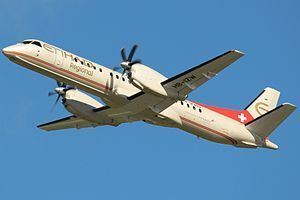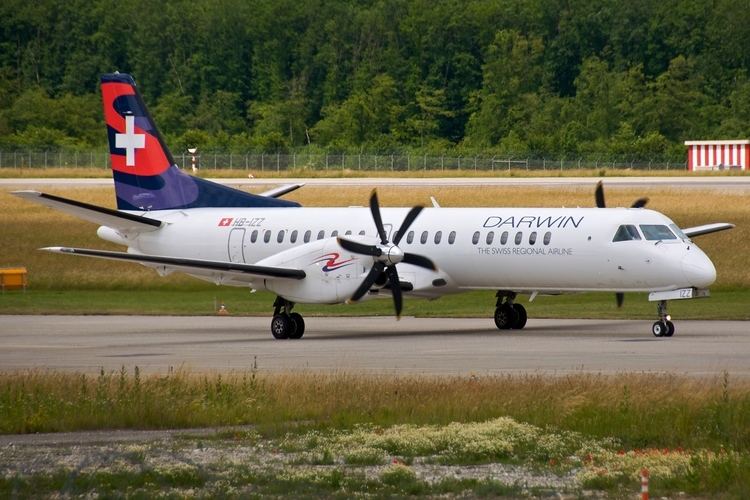Top speed 682 km/h Range 2,868 km Weight 13,800 kg Engine type Rolls-Royce AE 2100 | Cruise speed 665 km/h Wingspan 25 m Length 27 m | |
 | ||
Saab 2000
The Saab 2000 is a twin-engined high-speed turboprop airliner built by Saab. It is designed to carry 50–58 passengers and cruise at a speed of 665 km/h (413 mph). Production took place in Linköping in southern Sweden. The Saab 2000 first flew in March 1992 and was certified in 1994. The last aircraft was delivered in April 1999, a total of sixty-three aircraft being built and thirty-three remaining in service as of July 2013.
Contents
- Saab 2000
- Saab 2000 braathens regional take off at bern airport nice turboprop sounds
- Development and Design
- Operational history
- Variants
- Civilian operators
- Military operators
- Specifications
- Accidents and incidents
- References

Saab 2000 braathens regional take off at bern airport nice turboprop sounds
Development and Design

In December 1988, Saab decided to build a stretched derivative of its successful Saab 340 twin-turboprop regional airliner. The new aircraft was planned to meet a perceived demand for a high-speed 50-seat turboprop with good climb performance which could operate over short- and medium-range routes with similar block times to jet aircraft while retaining the efficiency provided by turboprop engines. The new airliner, called the Saab 2000, was formally launched in May 1989, with Saab already having firm orders for 46 aircraft and options for a further 147. The aircraft was assembled at Saab's Linköping factory, with major subcontractors including CASA, who built the aircraft's wings, Short Brothers, who built the rear fuselage and Valmet who built the aircraft's tail surfaces. The Saab 2000 first flew on 26 March 1992 and entered into scheduled airline service in September 1994, a few months after its certification by the Joint Aviation Authorities in March and the Federal Aviation Administration in April.
The Saab 2000 has a 15% greater wingspan than the Saab 340, and being 7.55 metres (24 ft 9 in) longer can carry up to 58 passengers in a high-density layout and 50 with a more comfortable 32 inches (81 cm) seat pitch. The 2000 was the first commercial aircraft to use the 4,591shp Rolls-Royce AE 2100 turboprop engines (then built by Allison), driving slow turning six-bladed Dowty Rotol propellers. One engine was mounted on each wing, as in the 340, with the engines placed further from the fuselage than those of the 340 to reduce cabin noise.
Operational history

Sales of the Saab 2000 were fairly limited. The major initial customer was Crossair, a regional airline which had Swissair as a 56% shareholder. Crossair took delivery of 34 aircraft and was still operating the type in 2005. Due to limited demand, Saab ceased production of the Saab 2000 in 1999, with the last aircraft being delivered to Crossair on 29 April of that year. General Motors (GM) operated several corporate-configured Saab 2000s and was in talks with new startup air carrier Pro Air to have this airline operate them in scheduled service as Pro Air Express in the U.S.; however, Pro Air then encountered financial difficulties and ceased all operations before the deal could be consummated. Air Marshall Islands also operated a Saab 2000 in the remote Micronesia island region of the Pacific Ocean.

By the year 2013, 57 Saab 2000 aircraft remained in service. The primary reason for the low sales was the success of newly introduced regional jets such as the Bombardier CRJ and Embraer ERJ 145 family which provided better performance and passenger comfort for the same initial price. Some smaller airlines, including Eastern Airways in the UK, have subsequently acquired 2000s at low cost and operated them on regional routes which experience lower passenger numbers as well on shuttle services in the U.K. for oil and gas personnel working in the North Sea.

In June 2006, Pakistan completed the purchase of six Saab 2000 turboprop aircraft to be equipped with the Saab-Ericsson ERIEYE Airborne Early Warning system. Revised in May 2007 due to renegotiation with the Government of Pakistan, only five aircraft will be delivered, four of which will be equipped with the Erieye system. On 3 April 2008, the first Saab 2000 Erieye AEW&C was rolled out and presented to Pakistan Air Force officials during a ceremony in Sweden.
Variants
Civilian operators
As of July 2016, a total of 35 Saab 2000s remained in airline service, operated by:
Military operators
Specifications
Data from Brassey's World Aircraft & Systems Directory 1999/2000
General characteristics
Performance
Avionics
